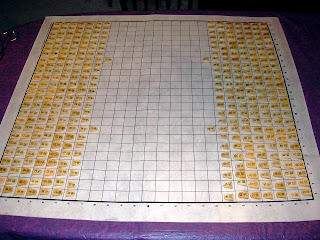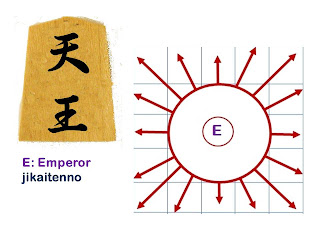Tai Shogi
has the notoriety of being the largest known historic chess variant in
the world. This game was probably invented before the end of the
sixteenth century. Tai Shogi has been invented by some recreational
megalomaniac and for good reason. This huge game is played on a
twenty-five by twenty-five board and each player has a grand total of
one hundred seventy-seven pieces. Counting promotion values, one hundred
and one different values exist in this game.
Objective
The game is played on a 25x25 square board, and each player manipulates 177 pieces. The pieces in Tai Shogi are flat and wedge shaped, with a uniform colour and the names printed in Japanese (the promoted value written in a different colour on the opposite side). Pieces point forward to indicate the ownership. To avoid confusion, one side is known as "white" and the other as "black". Pieces are made of wood.
The game is played like most other chess-like games, with the players making alternate moves. Some pieces can move twice, such as the Lion and Furious Fiend, but most can only make a single move.
Objective
The game is played on a 25x25 square board, and each player manipulates 177 pieces. The pieces in Tai Shogi are flat and wedge shaped, with a uniform colour and the names printed in Japanese (the promoted value written in a different colour on the opposite side). Pieces point forward to indicate the ownership. To avoid confusion, one side is known as "white" and the other as "black". Pieces are made of wood.
The game is played like most other chess-like games, with the players making alternate moves. Some pieces can move twice, such as the Lion and Furious Fiend, but most can only make a single move.
The object of the game is to capture both the opposing Emperor AND the Crown Prince. Both pieces must be captured to win. Also, if a player has promoted his Drunk Elephant to another Crown Prince, that must also be taken.
One game may be played over several long sessions and require each player to make over a thousand moves.
The game is played without drops, and uses a promotion-by-capture rule.

The objective of the game is to capture the opponent's emperor and crown prince (or princes). When the last of these is captured, the game ends. There are no rules for check or checkmate; however, in practice a player resigns when checkmated.
Game equipment
Two players, Black and White, play on a board ruled into a grid of 25 ranks (rows) and 25 files (columns), for a total of 625 squares. The squares are undifferentiated by marking or color.
Each player has a set of 177 wedge-shaped pieces of 93 types. In all, the players must remember 99 moves for these pieces. The pieces are of slightly different sizes.
_________
The Lance (L) can
move any number of free squares straight forward but can move in no
other direction. An unpromoted lance that reaches the farthest rank is
trapped.
The Turtle-Snake (TS) can
move any number of unobstructed spaces diagonally forward or
orthogonally backward, move up to two squares diagonally backward, or
move one square orthogonally forward.
The Whale (W)
can move any number of free squares directly forward or backward; or It
can move any number of free squares diagonally backward.
The Flying Dragon (FD) can
move one or two squares along one of the four diagonal directions.
Because it cannot move orthogonally, a flying dragon can only reach half
the squares on the board.
Promotion : Dragon King (DK)
Promotion : Dragon King (DK)
The Goblin (LO) can
move any number of free squares along one of the four diagonal
directions, then (optionally) turn 90° and move any number of free
squares in a perpendicular diagonal direction; or, It can step one
square in one of the four orthogonal directions.
The Dove (D) can move one or two squares in one of the four orthogonal directions; or it can move one to five squares in one of the four diagonal directions.
The Rook (R) can move any number of free squares along any of the four orthogonal directions.
The Dragon Horse (DH) can move any number of free squares along any of the four diagonal directions; or It can move one square in any orthogonal direction.
The Dove (D) can move one or two squares in one of the four orthogonal directions; or it can move one to five squares in one of the four diagonal directions.
The Rook (R) can move any number of free squares along any of the four orthogonal directions.
The Dragon Horse (DH) can move any number of free squares along any of the four diagonal directions; or It can move one square in any orthogonal direction.
The Dragon King (DK) can
move any number of free squares along any of the four orthogonal
directions; or, It can move one square in any diagonal direction.
The Free King (FK) can move any number of free squares along any one of the eight orthogonal or diagonal directions.
The Gold General (G) - can step one square in one of the four orthogonal directions; or, One square diagonally forward, giving it six possibilities.
The Gold General (G) - can step one square in one of the four orthogonal directions; or, One square diagonally forward, giving it six possibilities.
The Deva (DV) has
asymmetric options for movement. It can step one square diagonally
forward, in either direction; or, One square orthogonally to the left;
or, One square diagonally backward to the right.
The Emperor (E) is
the most important and the most powerful piece. It has the most wide
ranging move of any piece: the Emperor may move instantly to any square
on the board, regardless of any pieces in the way. The only restriction
to this move is that the Emperor cannot capture a piece that is
protected by another piece. "Protected" means that any adjacent pieces
have the ability to move to the square the protected piece is on.The Emperor must be captured in order to win the game, and it seems the only way to do it is to use your own Emperor, by first knocking out its defenders, leaving the Emperor helpless, then going in for the kill.
The Dark Spirit (DS) has asymmetric options for movement. It can step one square diagonally forward, in either direction; or, one square orthogonally to the right; or, one square diagonally backward to the left.
Promotion : Buddhist Spirit
Promotion : Buddhist Spirit
The White Tiger (WT) can move any number of free squares directly forward or backward; or, diagonally forward to the left; or, It can move one or two squares orthogonally sideways; or, It can step one square diagonally forward to the right.


















